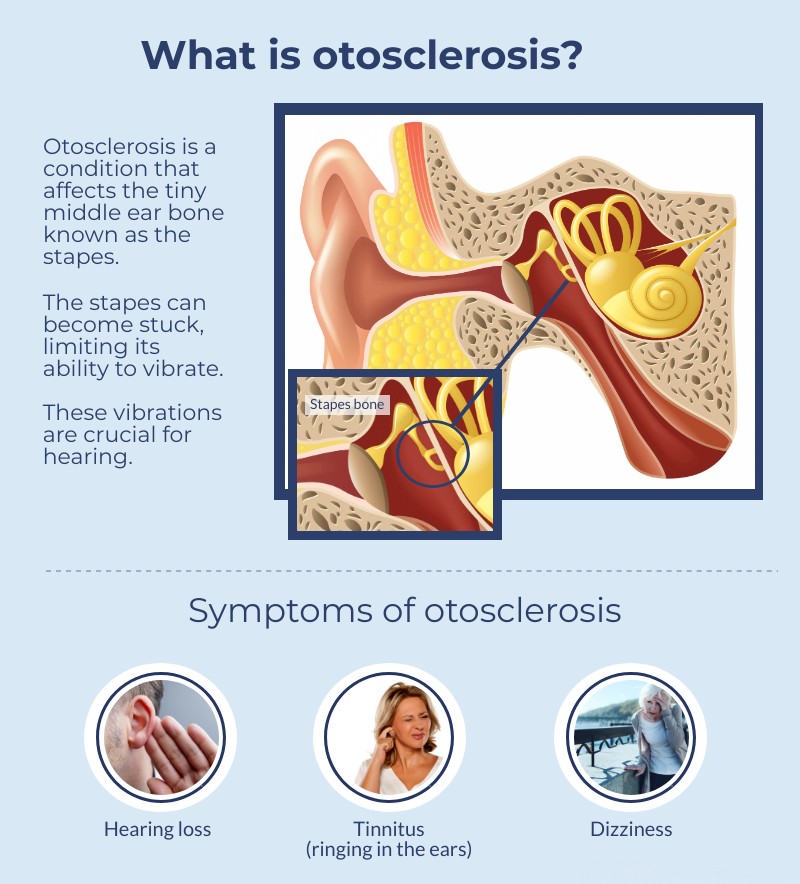
What is Otosclerosis & How Can it Affect Your Hearing
Reviewed by Dr. Porter on December 24, 2020
Otosclerosis is a rare condition that disrupts your ability to hear. The issue arises when a small bone in the ear, usually the stapes, gets fixed in one position. When this happens, the bone cannot vibrate and carry sound to the inner ear, which causes full or partial hearing loss. The fixation of the small bone and its inability to transmit sound is what makes otosclerosis.
While the experts do not know the true cause of otosclerosis there are things that can be done to help with the hearing loss. Harbor Audiology & Hearing Services will help you navigate and treat this condition.
Overview of Otosclerosis
Otosclerosis is a rare tissue growth disorder that affects the middle region of the ear. It happens when the tissue in your ear grows in a way that is shouldn’t, causing the bone that typically vibrates to be stiff and unable to move as it should. This impedes the sound from being transmitted through the middle ear to the inner ear. This results in a hearing loss that starts with a loss of low-pitched sounds or whispers, that typically worsens over time. This condition commonly affects both ears but in about 10-15% of the cases will affect only one ear.
Along with the hearing loss you may experience other symptoms with Otosclerosis including:
- Tinnitus: It can cause a ringing, hissing or even roaring sensation in the ears.
- Balance: Some will notice a feeling of vertigo, dizziness or loss of balance.
When the condition presents itself, a person often loses hearing in only one ear and then over time it goes on to the other ear. Otosclerosis commonly develops in younger people. It most typically starts to affect people in their 20s with the symptoms manifesting fully in their 30s. Researchers have shown that it most likely has a genetic component, although sometimes a carrier for this condition’s gene may fail to show any signs or symptoms of the disease. It affects mostly caucasians of European decent, with a much higher likelihood in women as compared to men.
What Causes Otosclerosis?
While there is no definite known cause according to researchers, there are at least five possibilities of why this condition occurs.
- It is genetically inherited.
- It could be a result of a past measles infection.
- It’s root cause comes from stress fractures in the bony tissue in the ears.
- It is caused by three different immune system cells when they interact. These immune system cells are responsible for healthy bone formation but only if they interact in the right scales.
- It is a result of a viral infection.
If you suffer from Otosclerosis, at least one of the above factors could be the cause. Sometimes it is impossible to know the specific reason; the only action you can take is having it treated, which you should do with haste. The sooner any issue is found and treated the better the outcome will be.

How Does an Otosclerosis Audiogram Work?
An audiogram measures hearing sensitivity. It is one of the significant tests carried out when you go to an ear clinic for diagnosis and treatment. It is a graph showing the softest sounds a person can hear across different frequencies. Normal hearing will be anything that can be heard at 20 decibels or less. If the softest the test can be heard at is at or above 25 decibels then a hearing loss is present. You will be tested with both air and bone conduction tests. The audiologist will look for a hearing loss, as well as other indicators of Otoclerosis.
If Otoclerosis is indicated then it will be recommended that you see an ear specialist such as an otolaryngologist or otologist for further testing. They specialize in treating any condition that may affect the ears and/or the surrounding areas including the nose, throat, and neck. When carrying out the diagnosis, the first step is to examine a person to rule out other conditions that may manifest like otosclerosis.
How to Treat Hearing Loss Caused by Otosclerosis
The ear specialists at Harbor Audiology & Hearing Services suggest catching ear problems early since most issues with the auditory system will become harder to treat the longer you wait. This case applies to Otosclerosis, which is easier to treat in its early stages of development. An ear specialist will commonly recommend hearing aids for people with Otosclerosis.
Another possible treatment is a stapedectomy procedure, where a surgeon removes the stapes and replaces it with an artificial device. If effective the result will allow sound waves to be sent once again to the inner ear. Before the procedure, a surgeon will give you a clear outline of what it entails and its risks and limitations. Only after close reexamination can the process begin since it can sometimes cause the condition to worsen.
For the correct diagnosis and treatment of this condition, please call and schedule an appointment with Harbor Audiology & Hearing Services, at any of our 6 convieniently located clinics.
Categorised in: Hearing Loss






